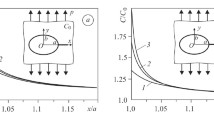Abstract
A generalized mathematical model of the interaction between hydrogen and structural defects in metals is analyzed. The temporal dependence of hydrogen permeation flow is examined for three typical cases. The approximations to the general equation for hydrogen permeation flow obtained enable one to determine the interaction from experimental data. The extreme values of permeation flow are analyzed. A method for determining the kinetic parameters of interaction for a given permeation flow is suggested. The conclusion is made that, within the framework of the generalized model, it is possible to establish the mechanism of hydrogen trapping.
Similar content being viewed by others
References
V. B. Kleshnya and N. G. Krapivnyi, “Study of the kinetics of interaction between hydrogen and structural defects in metals,”Fiz.-Khim. Mekh. Mater., No. 5, 23–27 (1992).
N. G. Krapivnyi, V. B. Kleshnya, and V. I. Sobornitskii, “Study of the interaction of hydrogen with structural defects in metals by electrochemical methods,” in:Abstracts of XII Conf. on Protection of Metals against Corrosion (October 1990, Perm') [in Russian], Perm' (1990). p. 60.
A. McNabb and P. K. Foster, “On the rate of loss of hydrogen from cylinders of iron and steel,”Trans. Met. Soc. AIME 227, No. 3, 618–627 (1963):233, No. 5, 1022–1031 (1965).
G. R. Casky and W. L. Pillinger, “Trapping on hydrogen permeation,”Metall. Trans. A 6A, No. 3, 467–476 (1975).
M. Iino, “A more generalized analysis of hydrogen trapping,”Acta Metall. 30, No. 2, 367–375 (1982)
M. Iino, “Analysis of irreversible hydrogen trapping,”Acta Metall. 30, No. 2, 377–383 (1982).
M. Iino, “Trapping of hydrogen by sulfur associated defects in steel,”Metall. Trans. A 16A, No. 3, 401–410 (1985).
E. Wu, “A mathematical treatment of the electrochemical method of hydrogen permeation and its application in hydrogen traps and embrittlement,”J. Electrochem. Soc. 134, No. 9, 2126–2132 (1987).
A. Turnbull, M. W. Carroll, and D. H. Ferriss, “Analysis of hydrogen diffusion and trapping in a13% chromium martensitic stainless steel,”Acta Metall. 37, No. 7, 2039–2046 (1989).
Su-ll Pyun and R. A. Oriani, “The permeation of hydrogen through the passivating films on iron and nickel,”Corrosion Sci. 29, No. 5, 485–496 (1989).
J. O'M. Bokris and P. K. Subramanyan. “Hydrogen embrittlement and hydrogen traps,”J. Electrochem. Soc. 118, No. 7, 1114–1119 (1971).
Additional information
Dnepropetrovsk Institute of Chemical Engineering, Dnepropetrovsk. Translated from Fiziko-Khimicheskaya Mekhanika Materialov, Vol. 29, No. 5, pp. 25–29, September–October, 1993.
Rights and permissions
About this article
Cite this article
Kleshnya, V.B., Krapivnyi, N.G. A generalized model for the interaction between hydrogen and structural defects of the solid phase. Mater Sci 29, 455–459 (1994). https://doi.org/10.1007/BF00558764
Received:
Issue Date:
DOI: https://doi.org/10.1007/BF00558764




